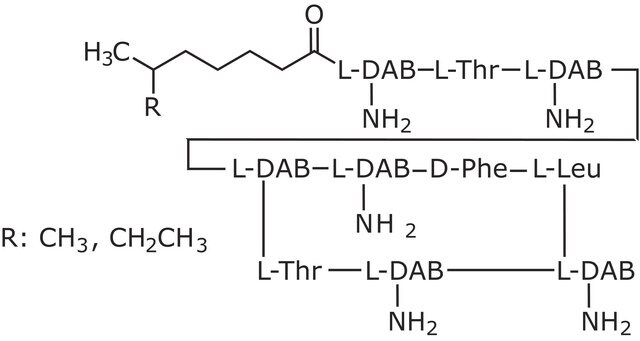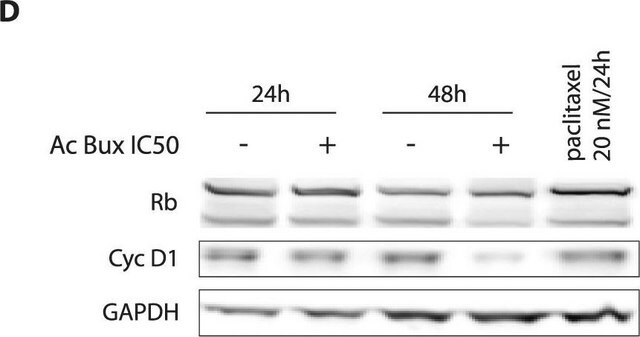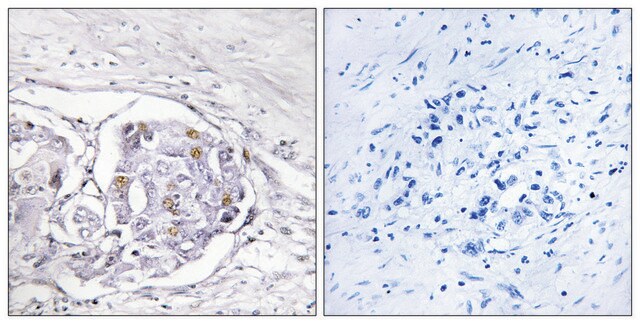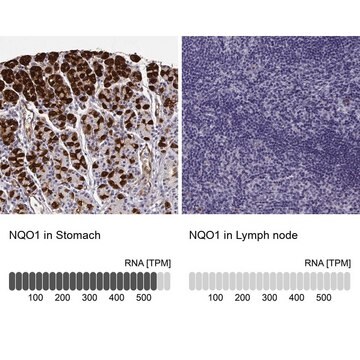추천 제품
생물학적 소스
mouse
결합
unconjugated
항체 형태
purified immunoglobulin
항체 생산 유형
primary antibodies
클론
122.2, monoclonal
양식
buffered aqueous solution
분자량
antigen ~180 kDa (higher band may be present)
종 반응성
rat
포장
antibody small pack of 25 μL
농도
~2 mg/mL
기술
immunocytochemistry: suitable
immunohistochemistry: suitable
western blot: 0.2-0.4 μg/mL using total extract of rat brain
동형
IgM
UniProt 수납 번호
배송 상태
dry ice
저장 온도
−20°C
타겟 번역 후 변형
unmodified
유전자 정보
rat ... Ptprz1(25613)
일반 설명
Monoclonal Anti-Phosphacan (mouse IgM isotype) is derived from the hybridoma 122.2 produced by the fusion of mouse myeloma cells (P3X cells) and splenocytes from BALB/c mice immunized with rat brain proteoglycans. Chondroitin sulfate proteoglycans are neural cell adhesion molecules (NCAM) ligands present in the brain extracellular matrix (ECM). Phosphacan protein is expressed mainly in astrocytes and is a ligand for NCAM. Phosphacan is the soluble extracellular domain of the receptor-type transmembrane protein tyrosine phosphatase (RPTPb).
면역원
rat brain proteoglycans.
애플리케이션
Monoclonal Anti-Phosphacan antibody produced in mouse has been used in:
- immunoblotting
- immunohistochemistry
- immunocytochemistry.
생화학적/생리학적 작용
Phosphacan levels elevates during late embryogenesis. It reaches a plateau two weeks postnatal before reaching stable. Receptor-type transmembrane protein tyrosine phosphatase (RPTPb) functions to promote primary tecal neurons neurite growth, neural migration and also induces cell adhesion. Both phosphacan and RPTPb can bind to NCAM and tenascin-C and −R. Phosphacan can oppose RPTPb by competing for its binding sites. Both in hippocampal and spinal cord neurons, phosphacan can affect neuronal adhesion and neurite outgrowth.
물리적 형태
Solution in 0.01 M phosphate buffered saline, pH 7.4, containing 15 mM sodium azide.
면책조항
Unless otherwise stated in our catalog or other company documentation accompanying the product(s), our products are intended for research use only and are not to be used for any other purpose, which includes but is not limited to, unauthorized commercial uses, in vitro diagnostic uses, ex vivo or in vivo therapeutic uses or any type of consumption or application to humans or animals.
적합한 제품을 찾을 수 없으신가요?
당사의 제품 선택기 도구.을(를) 시도해 보세요.
Storage Class Code
10 - Combustible liquids
WGK
WGK 3
Flash Point (°F)
Not applicable
Flash Point (°C)
Not applicable
개인 보호 장비
Eyeshields, Gloves, multi-purpose combination respirator cartridge (US)
가장 최신 버전 중 하나를 선택하세요:
Receptor protein tyrosine phosphatases in nervous system development
Johnson KG and Van Vactor D
Physiological Reviews, 83(1), 1-24 (2003)
The tissue plasminogen activator (tPA/Plasmin) extracellular proteolytic system regulates seizure-induced hippocampal mossy fiber outgrowth through a proteoglycan substrate
Wu YP, et al.
The Journal of cell biology, 148(6), 1295-1304 (2000)
Y P Wu et al.
The Journal of cell biology, 148(6), 1295-1304 (2000-03-22)
Short seizure episodes are associated with remodeling of neuronal connections. One region where such reorganization occurs is the hippocampus, and in particular, the mossy fiber pathway. Using genetic and pharmacological approaches, we show here a critical role in vivo for
RGMa mediates reactive astrogliosis and glial scar formation through TGFbeta1/Smad2/3 signaling after stroke
Zhang R, et al.
Cell Death and Differentiation, 25(8), 1503-1503 (2018)
Rongrong Zhang et al.
Cell death and differentiation, 25(8), 1503-1516 (2018-02-06)
In response to stroke, astrocytes become reactive astrogliosis and are a major component of a glial scar. This results in the formation of both a physical and chemical (production of chondroitin sulfate proteoglycans) barrier, which prevent neurite regeneration that, in
자사의 과학자팀은 생명 과학, 재료 과학, 화학 합성, 크로마토그래피, 분석 및 기타 많은 영역을 포함한 모든 과학 분야에 경험이 있습니다..
고객지원팀으로 연락바랍니다.








